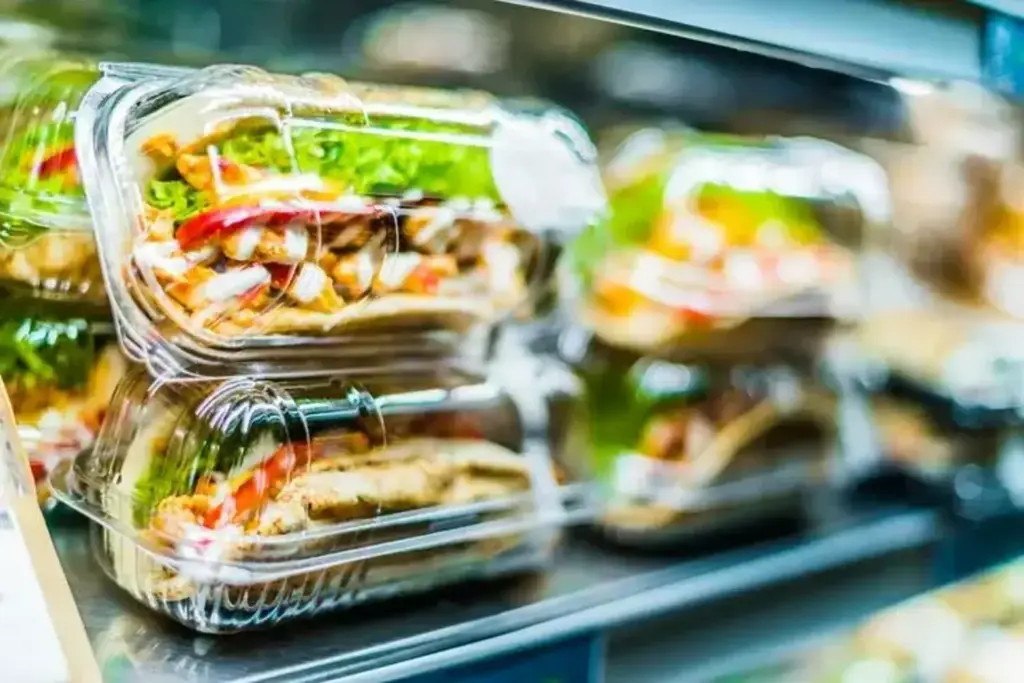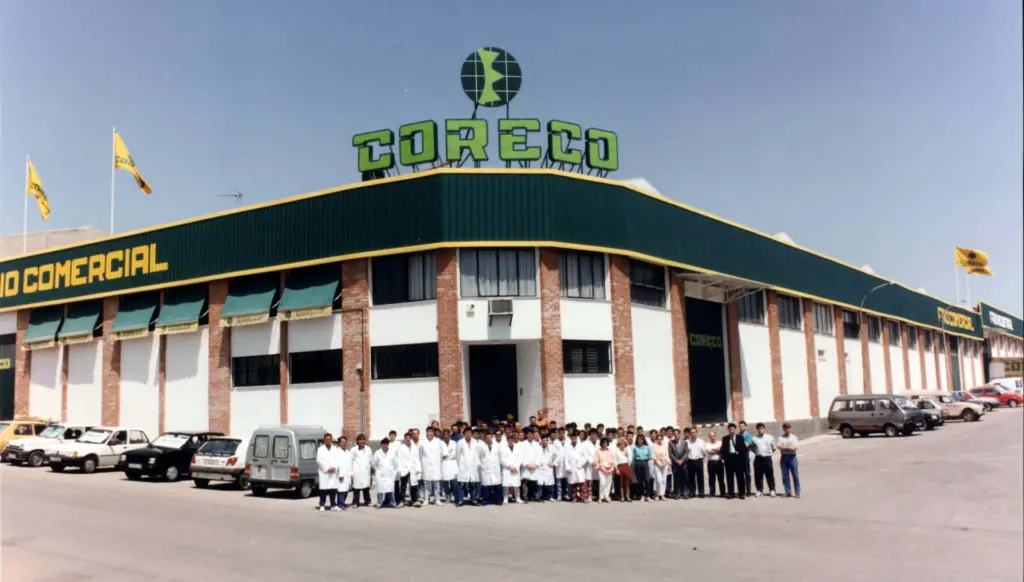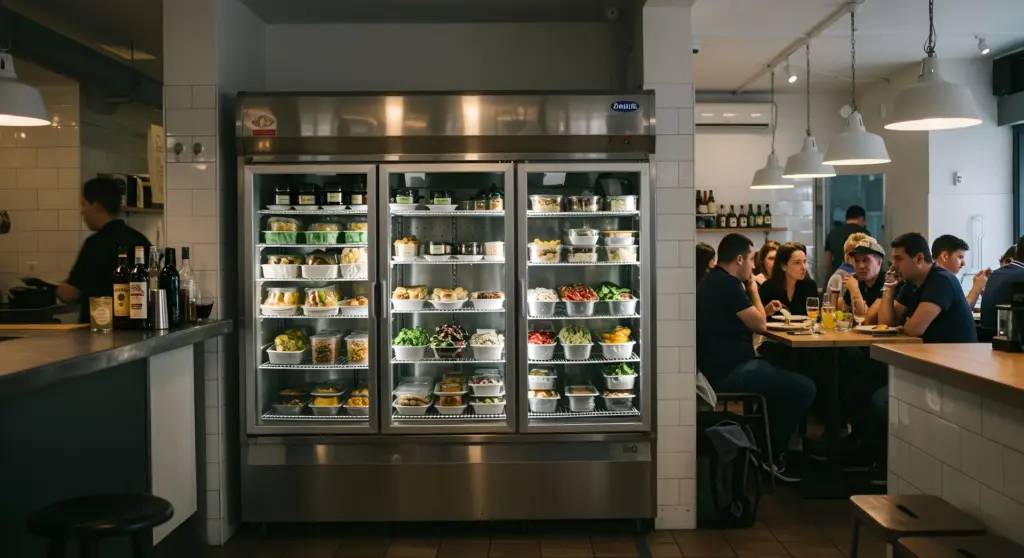At Coreco Gourmet we start from a clear base: who distributes our equipment knows how to sell. We have spent years sharing the road with professionals who know the Horeca channel in detail, who have closed complex operations and who know how to adapt to each client. This article is not intended to teach them what they have already mastered. Quite the contrary: it is born out of respect for that experience. What we want is to offer new tools, remind us of approaches that are perhaps more necessary today than ever, and reinforce with current arguments what has always worked: selling on the basis of value. Because in an increasingly competitive market, even the best product needs to be presented with intelligence, commercial sensitivity and a discourse that connects. And that is where a data sheet alone is no longer enough.
Selling industrial refrigeration equipment today involves much more than listing technical specifications. In an increasingly competitive market, whether gourmet or standard, commercial success is achieved when each piece of information is translated into a tangible promise to the customer. The technical data sheet provides confidence, but the real value is communicated through the experience of use and the concrete benefits that the equipment provides in the dining room, kitchen or point of sale.
Not everything is written in the technical documentation
For years, the sale of industrial refrigeration equipment has relied on technical documents: data sheets, drawings, consumption, dimensions, gases. Although these data are still essential, today they are no longer sufficient. The Horeca professional has changed. Now they demand solutions, they visualise brands, they value design, they look for sustainability and, above all, they need to be excited before deciding.
To sell industrial refrigeration equipment effectively, it is essential to adapt the discourse to the type of customer. A chef is not looking for the same thing as a purchasing manager or an installer. Therefore, beyond the technical characteristics, the real challenge lies in building a lively argument that transforms data into visual, emotional and functional solutions.
This article is created to distributors, sales technicians and sales teams who work with premium equipment in the Horeca channel. Here you will not learn how to recite characteristics, but rather how to translating specifications into real benefits. You will learn how to connect with the client emotionally and functionally, how to identify their real fears and motivations, and how to use the fact sheet only as a support, not as the main argument.
Why is the datasheet no longer sufficient?
In the premium industrial refrigeration sector, purchasing decisions are no longer made solely on the basis of data. They are made on perceptions, emotions, brand vision and projected reputation. A team can have all the certifications and optimal parameters, but if it is not connected to the client's desire, pain or ambitionThe operation is not closed.
And this is not an opinion. According to a Harvard Business Review study on decision-making in complex B2B environments:
🔎 "71% of B2B buyers say they value an emotional connection with the supplier more than purely functional differentiation."
What does this mean in professional refrigeration? It is not enough to say that the equipment has triple glazing or natural refrigerant. You have to say what the customer gains with that: more margin, more prestige, more product turnover or less risk in the future.
What really sells? The combination of the functional and the emotional
In many of the cases we have collected, the difference between presenting and selling industrial refrigeration equipment has been in how the story of the equipment was told. Showing it integrated into the space, explaining the real savings it represents or connecting with the customer's values has made the difference, not the power table or the temperature range.
Investment decisions in gourmet industrial refrigeration are made at three levels:
- Rational: consumption, standards, durability, capacity.
- Functional: ease of cleaning, maintenance, real cost-effectiveness.
- Emotional: image, confidence, product visibility, pride of display.
🎯 Example of actual translation:
| Technical specification | Emotional and functional translation |
|---|---|
| Triple glazing with inert gas | "Your products are always visible, without tarnishing. They look as they deserve. |
| Inverter compressor | "Quiet. It doesn't disturb the room or alter the customer experience." |
| R290 (natural refrigerant) | "You won't have to change equipment because of the new regulations. Investment protected." |
| Merma <10% with Master Ageing Controller | "You earn more with every piece of meat. You sell quality, but also profitability. |
How to turn specifications into arguments that close sales
Here is a simple methodology to transform any data sheet into a more effective sales conversation:
1. Detects the type of client
| Type of customer | What's on your mind | How you should approach your speech |
|---|---|---|
| Gourmet chef or owner | Experience, taste, presentation | It speaks of visibility, maturity, excellence |
| Technical chain buyer | Regulations, standardisation, maintenance | Focuses on efficiency, connectivity, compliance |
| Local distributor | Rotation, ease of installation, support | Show stock, after-sales service and branding benefits |
| Gourmet retail / butchery | Margin per product, shop aesthetics | It talks about visibility, exposure and profitability per m² |
2. Translates each characteristic into an applied benefit
| Technical characteristics | Functional benefit | Emotional benefit |
|---|---|---|
| LED lighting | Energy saving, better illuminated product | The customer finds the product more appealing |
| AISI-304 steel | Hygiene, easy cleaning | Image of professionalism and quality |
| Digital HACCP control | Guaranteed food security | Conveys consumer confidence |
| Visible design with glazed doors | Improve the presentation | Raises the perception of the average ticket |
How to build a living sales pitch (and not die with a generic one)
Many commercial teams continue to operate with standard argumentsClosed, PDFs that age as fast as the customer's priorities change. Well-thought-out, but repeated phrases. Competitive advantages that today everyone proclaims. The problem is not having an argument. The problem is that it does not evolve.
In this section we propose a practical methodology so that you, as a distributor or sales technician, can build and maintain a live sales pitchThe Coreco Gourmet system is adaptable, customisable, customisable and always aligned with Coreco Gourmet values: precision, efficiency, design, sustainability and profitability.
At Coreco Gourmet we know that selling industrial refrigeration equipment is not only about performance and regulations, but also about transmitting profitability, design and sustainability. And that can only be achieved with a commercial discourse that knows how to connect with what the customer really values.
What is a living sales pitch?
A living sales pitch is a dynamic tool, designed to evolve with the market and with customers' real needs. Its aim is not to recite technical data sheets, but to offer an adaptable guide to help sell industrial refrigeration equipment in changing contexts, with messages that resonate on both a rational and emotional level. This type of argumentation is built from the distributor's daily experience and is fed by real cases, updated regulations and the customer's most frequently asked questions.
It is a system of messages, strengths and comparative ideas:
- Adapts to the type of customer
- Evolves with the product and the market
- Integrates real cases, new regulations and trends
- It is built from the reality of use, not from technical theory.
It is not a static document, but a resource that is fed, adjusted and trained.
Basic structure of a living argumentation for gourmet industrial refrigeration
| Block of the argument | Key content | What it should include |
|---|---|---|
| 1. Frequent customer problems | Real pain, common complaint, unmet need | "I can't justify the price of the product", "It doesn't fit in my living room", "It makes too much noise", "It doesn't comply with the regulations". |
| 2. Clear promises from the team | Tangible, concrete, credible solution | Reduce shrinkage", "Display the product with aesthetics", "F-Gas 2024 compliant", "F-Gas 2024 compliant". |
| 3. Real evidence or example | Customer case, data, similar experience | "A butcher in Bilbao increased his average ticket by 18 % by placing the DAV-400 in the butcher's room". |
| 4. Question or visualisation involving the customer | Generates reflection and desire | "What if this was the first thing your client saw when they came in?" |
| 5. Expected objection + strong response | "It's expensive", "Doesn't it consume a lot?", "What if it fails?" | Answers based on ROI, regulation, efficiency and design |
How to build it with your team (step by step)
To sell industrial refrigeration equipment effectively, your sales team needs more than technical training: they need to train how to communicate the benefits. Building a living argument starts with collecting real objections, translating features into tangible value and adapting messages to the customer's language. Engage your team in hands-on sessions, role-plays and constant updates so that every sales person has not only data at hand, but arguments that connect and convince.
- Brainstorm real objections that have made you clients this year.
- Collect phrases that have worked in real closures.
- Rewrite product promises in street languagenot token.
- Create different versions for each type of customer or channel.
- Update every 6 months with technical developments, new cases and regulatory changes.
- Train the use of argumentation in role-play dynamics.
What does your team gain from a living argument?
A lively sales pitch not only improves the confidence of the sales team, it also speeds up closures and strengthens the relationship with the customer. When each member of the team knows how to sell industrial refrigeration equipment by interpreting what the customer needs - and not just repeating what the data sheet says - the result is a smoother, more persuasive and more effective conversation. Trust is increased, objections are resolved quickly and the value of the product is communicated in a memorable way.
- More naturalness in the sales conversation
- Quicker to respond to objections without improvising
- Real differentiation from competitors with generic discourse
- Increased customer confidence that "you are talking to him", not to everyone.
Real life example: mini living argumentation for DAV-400 (maturation)
| Target customer | Pain | Pledge | Actual test | Common objection | Response |
|---|---|---|---|---|---|
| Gourmet butchery | "I don't justify the price of Dry Aged". | "With this equipment you can see the process and reduce shrinkage to 9 %". | "A customer in Valencia increased its Dry Aged sales by 22 % in 6 months". | "It's a lot for my space". | "It is 68 cm deep. It fits where a camera can't fit". |
| Premium restaurant | "My customers don't understand the value of the product". | "When they see it mature, they understand the price without explaining it". | "In Porto, a chef put it on display and increased meat orders by double". | "What if I don't fill it all the time? | "You can work from 1 piece. You don't need volume, you need visibility". |
Conclusion: Selling is interpreting, not reciting.
A technical argument can inform.
A good commercial with a lively argument converts.
And in a gourmet market where everything changes fast, who updates his arguments, gains the customer's trust before talking about price.
Most common mistakes when selling with a technical data sheet (and how to avoid them)
Although technical arguments are essential in any professional equipment sales process, it is easy to fall into automatisms that limit the connection with the customer.. In many cases, a valuable opportunity is lost by presenting equipment as a list of features rather than as a strategic solution. This section covers the most common mistakes we see in day-to-day distribution and, more importantly, the most common mistakes we see in day-to-day distribution, proposes practical alternatives to turn them into strengths of commercial discourse.
| ❌ Error | 🚫 Why it fails | ✅ Effective alternative |
|---|---|---|
| Start with the data sheet | Generates distance with the customer | Start with the context of the client and what they are looking for. |
| Use only technical jargon | Only connects with highly technical profiles | Use language that describes concrete benefits |
| Ignoring aesthetics | The gourmet customer values design | Show photos of actual integration in the room |
| Failure to explain sustainability | It is a decisive value today | It talks about regulatory compliance and green gases |
Sales techniques according to channel
Not all clients have the same objectives, needs and priorities. Selling to a chef with signature cuisine is not the same as talking to the purchasing manager of an international chain.. Therefore, adapting the approach to the type of channel is not only recommended, it is mandatory if you want to close effectively. In this section you will find specific keys to adjust your speech to each profilewith the points that generate the most impact depending on the business model you are facing.
🧑🍳 Independent restaurants
- Show the impact on the letter: "With this cabinet, you can add a Dry Aged section and differentiate yourself."
- Highlighting the room experience: "Your customers will see it, they will associate it with your kitchen. There is no better marketing.
🏬 Catering chains
- Emphasises standardisation: "Same result, same temperature, same quality anywhere in the world".
- Rely on regulation and efficiency: "Equipment ready for F-Gas 2024. No future surprises".
🛍 Gourmet shops or premium butcher's shops
- It speaks of active exposure: "Your showcase doesn't just conserve, it converts.
- Argues medium ticket and rotation: "Every kilo matured is worth more and is better justified".
Template: from technical data to emotional arguments
The best way to prepare an effective sale is not to memorise the data sheet, but rather to know how to translate each specification into a benefit that the customer can visualise, feel or measure in their business. That is why in this section we offer you a practical tool: a template that allows you to move from the technical data to the business case with a simple and straightforward structure. It is a guide that you can use internally or turn into a training dynamic for your team.
| Technical data | What does it do? | I beg your pardon? |
|---|---|---|
| Low-emissive glass | Prevents condensation | "It will always look clear, even in wet conditions. Your product is always in the spotlight. |
| Quiet compressor | Reduces ambient noise | "You can't even hear it. The atmosphere in your living room is not disturbed." |
| HACCP touch panel | Control and traceability | "If an inspector comes in, you have all the data at a touch." |
| Specific interior LED | Improved product illumination | "Every piece shines. Literally." |
| Gas R290 | Eco-efficiency | "It complies with the most demanding European regulations. Your investment is secure". |
Case studies: how sales were closed without using only the technical data sheet
Nothing reinforces learning as much as see how others have successfully applied the same approach. In this section we present several real cases - based on the experiences of distributors, installers and end customers - that illustrate how deals can be closed without relying exclusively on tokens. We show you what was said, how it was presented and what the result was. Because when the arguments connect with the customer, the sale flows.
🥩 Boutique butcher's shop in Valencia
Product: DAV-400 for Dry Aged maturation
Technique: Show the equipment in the room, with light simulation and real cutting on display.
Key phrase: "This is not a camera. It's your best showcase."
Result: 22 % increase in sales of premium cuts in 6 months.
🍷 High-end restaurant in Oporto
Product: DAW-200 wine cellar
Technique: Integrated design in the room plan + wine storytelling.
Key phrase: "Every bottle tells a story. This is where it begins."
Result: Implementation in 4 restaurants of the group.
🧊 5 star hotel in Madrid
Product: GAB-10P Pumper
Technique: Explanation from food safety + time saving in the kitchen
Key phrase: "In 90 minutes, you gain time, taste and safety. All in one.
Result: Replacement of old blast chillers for the entire Coreco range.
How to train your sales team in arguments that sell
Having a technically well-prepared team is a solid foundation, but training to sell value - not just product - is what makes the difference in the premium sector. This section proposes a practical approach to train your team in the interpretation of arguments, the use of visual tools, the handling of objections and the connection with the customer from their reality and not from that of the manufacturer. Because each sale involves much more than a team: a relationship is built.
- Make mock sales without a technical sheetThey should learn to talk about benefits first.
- Rewrite the fiches with commercial languagethat each piece of data has an applicable translation.
- Take guided tours with storytellingshows how the equipment behaves in the room or in the shop.
- Prepare visual comparisonsbefore/after, visibility, noise, average ticket.
- Train real objectionsnoise, price, regulation, return. It gives answers based on impact, not just function.
Conclusion: The data sheet informs. But it doesn't make you fall in love with it.
And no one buys premium equipment without feeling confident, convinced and connected to their choice. Selling industrial refrigeration today is also selling image, profitability and reputation.
That is why at Coreco Gourmet we design technologies that speak for themselves. But we know that a good salesperson doesn't just describe them: converts them into value for the customer.
"The data sheet doesn't make sales by itself. What sells is how you interpret it so that the customer can see what problems it solves".










